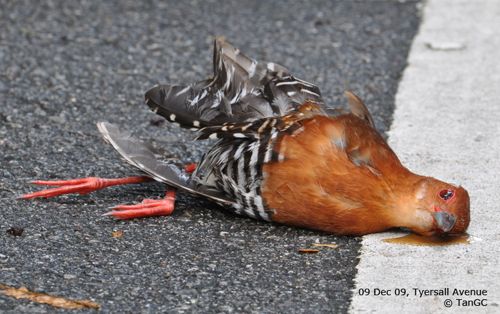Tan Gim Cheong came across a dead Red-Legged Crake (Rallina fasciata) lying on the road at Tyersall Avenue on the evening 9th December 2009. “Must have been hit by a vehicle as it tried to cross the road. The impact point seems to be on the head. It is now in the RMBR,” wrote Gim Cheong.
RMBR refers to the Raffles Museum of Biodiversity Research at the National University of Singapore. For details on the importance of sending specimens to the museum and who to contact, please see HERE.
In April 2009, one was knocked down along Tyersall Road. Fortunately the bird was slightly hurt and after some care, it recovered and was released. In November the same year another was fond dead along South Buona Vista Road. There may be others but not reported.
The Red-legged Crake is an uncommon resident and a winter visitor to Singapore. The pattern of its activity is very much unknown. What we know is that many species of Rallidae (rails, gallinules and coots) are active during the day, roosting at night. Many others are predominantly crepuscular, meaning that they are active at dawn and dusk, rather than in full darkness or daylight. These are their most active feeding periods, spending the middle of the day in rest under shelter.
According to Wells (1999), “Best known as a nocturnal migrant, with numerous reports of strikes on lights inland…” It is possible then that its movements in urban areas between vegetation covers under low light conditions make them vulnerable of being knocked down by passing vehicles. However, this particular bird must have been knocked down during the day as it was still fresh when found in the evening.
Reference:
Wells, D.R., 1999. The birds of the Thai-Malay Peninsular. Vol. I, Non-passerines. Academic Press, London. 648 pp.










3 Responses
This bird must have just been knocked down. The Red-legged Crake (resident population) has crespecular tendencies, becoming active and vocal during the last hour or two of daylight and feeding until well after dark (birds have been observed feeding in a stream at 9pm).
They also seem to be active in the morning but tend to rest during the heat of the day. This is the only true resident woodland crake in Singapore.
Based on my field studies, this crake is actually a fairly common and widespread resident, in nearly all wooded habitats throughout our nation.
very sad.
It’s quite unfortunate that a lovely bird such as this Crake has to depart this way. Hope its mate is doing well. Tis no wonder they havnt been returning to their bathing spot of late.